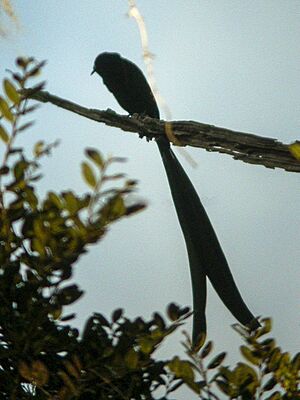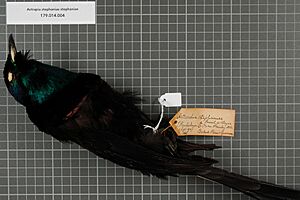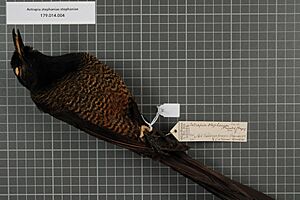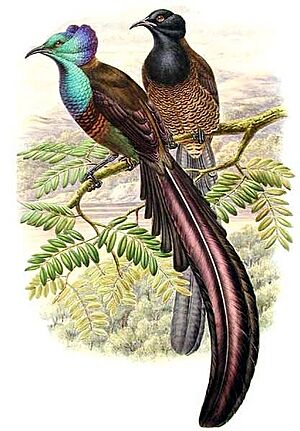Princess Stephanie's astrapia facts for kids
Quick facts for kids Princess Stephanie's astrapia |
|
|---|---|
 |
|
| Conservation status | |
| Scientific classification | |
| Genus: |
Astrapia
|
| Species: |
stephaniae
|
The Stephanie's astrapia (Astrapia stephaniae), also known as Princess Stephanie's astrapia, is a beautiful bird-of-paradise. These amazing birds live in Papua New Guinea. They are part of the Paradisaeidae family, famous for their stunning feathers.
This bird was first discovered in 1884. Today, the Princess Stephanie's astrapia is quite common in its home. Because of this, it is listed as "Least Concern" by the IUCN Red List. This means it is not currently in danger of disappearing. It is also protected under CITES, which helps control trade of wildlife.
Contents
What's in a Name?
The scientific name for this bird is Astrapia stephaniae. The first part, Astrapia, means "flash of lightning". This name fits well because many astrapia birds have shiny, iridescent feathers that seem to flash in the light.
The second part of the name, stephaniae, honors a real person. It was named after Princess Stéphanie of Belgium. She was the wife of Rudolf, Crown Prince of Austria. Another bird, the Blue bird-of-paradise, also has a scientific name that honors her husband, Rudolf.
What Does It Look Like?
The Stephanie's astrapia is a very unique bird-of-paradise. It's easy to spot!
Male birds are much more colorful than females. They can grow to about 84 cm (33 inches) long. A big part of this length comes from their two super long tail feathers. These glossy black feathers can be up to 47 cm (18 inches) long!
The male's head is a shiny greenish-blue, turning indigo blue at the back. Its throat and upper chest are a bright aqua or greenish-blue. Below this, there's a narrow, shiny coppery-red band. The rest of its body is a dull coppery-red or black. Its back is a dull light-green, and its wings are black with a purple shine. The long tail feathers are black with a purple gloss and white centers. Males have dark brown eyes, a black beak, and grey-black feet.
Female birds look very different from males. They are mostly dark brown. Their head and upper chest are dark black-bluish. Their underside has black bars on a cinnamon-brown color. Females also have a fairly long, blackish tail.
Hybrid Birds
Sometimes, the Stephanie's astrapia mates with another type of astrapia called the ribbon-tailed astrapia. This happens in areas where both birds live. When they have babies together, these hybrid birds are called "Barnes's astrapia". These special birds have very long tail feathers that can be a mix of black and white.
What Do They Eat?
Stephanie's astrapias mostly eat fruit. They especially like fruit from a plant genus called Heptapleurum. But they also eat small animals. Their diet can include frogs, insects, spiders, and even some types of skinks (small lizards).
These birds usually feed alone. Sometimes, they might join other birds-of-paradise, like the Brown sicklebill, or other bird species while looking for food.
How Do They Find Mates?
The breeding season for these birds usually happens from May to July. However, they can reproduce at other times of the year too.
Male Stephanie's astrapias try to attract many females. They do this by gathering in special spots called "leks." Here, they call out to females and perform displays. There might be up to five males displaying at once, but usually, there are about three.
During the display, males hop between different perches. They swap places and sometimes chase the female from one perch to another. After mating, the female bird does all the work of building the nest and raising the chicks by herself. This is common for most birds-of-paradise species.
Family and Relatives
The Stephanie's astrapia belongs to the Astrapia genus. It is most closely related to the ribbon-tailed astrapia. Both birds look quite similar, but the Stephanie's astrapia does not have the fluffy feathers that the ribbon-tailed astrapia has on its head.
The Astrapia genus is part of a larger group that includes the Epimachus and Paradigalla genera. The astrapias are closer to the Paradigalla birds.
There are two recognized types, or subspecies, of Stephanie's astrapia:
- Astrapia stephaniae feminina — found in the Schrader and Bismarck mountain ranges.
- Astrapia stephaniae stephaniae — found in the Owen Stanley Range.





